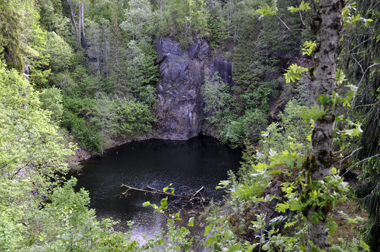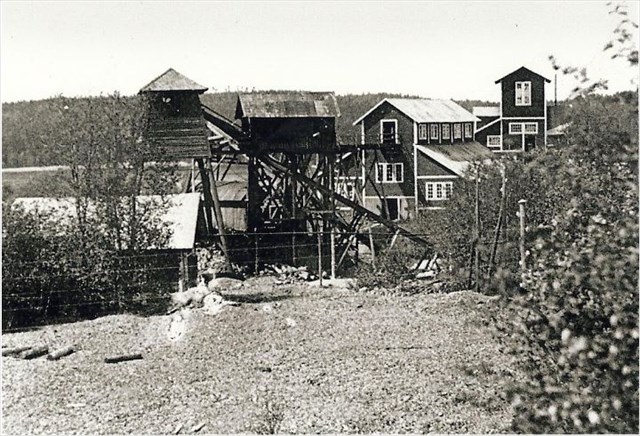 TILLFÄLLIGT problem. Batteripack med USB-uttag behövs för att komma åt finalen så länge detta meddelande finns här i beskrivningen. Ledsen för det. Generatorn är bytt flera gånger, och åtgärdas nu inte mer
TILLFÄLLIGT problem. Batteripack med USB-uttag behövs för att komma åt finalen så länge detta meddelande finns här i beskrivningen. Ledsen för det. Generatorn är bytt flera gånger, och åtgärdas nu inte mer


Här i
Klacka-Lerbergs kulturmiljö kan vi se avtryck av mänsklig verksamhet under århundraden i och med gruvbrytningen. Här finns ett 40-tal gruvhål och provbrytningar, malmtorg och stora skrotstenshögar. Olika tidsepoker har lämnat olika spår, kalhyggen, tillmakningsbrytning, dynamitanvändande och länspumpning är sådant som för alltid påverkat naturens utformning här.
De äldsta berättelserna om gruvområdet härrör från 1300-talet. Riktigt omfattande blev dock inte verksamheten förrän hertig Karl på 1600-talet beordrade en effektivare dränering av gruvorna. I början var det enskilda bergsmän, bönder som drev bergsbruk, som tillsammans med sina familjer arbetade i sina egna gruvor. Senare slog man sig samman i bergslag för samarbete. Från ca 1850 tog gruvbolag över driften och så fortskred det fram till nedläggningen 1932.

Byggandet av
Konungastollen var ett stort steg i områdets utveckling. En stoll är en horisontell gång som används för att leda bort grundvatten och underlätta utforsling av malm, samt för transport av ved och arbetskraft in i gruvan. Man byggde på den under precis 100 år och kom 270 meter in i berget, men nådde aldrig målet. Man fann istället mycket malm på vägen. Blivande kung Gustaf III besökte 1768 Konungastollen och lät rista in sitt namn i en minnessten. Den står idag uppe i byn Klacka-Lerberg vid fd Bergsskolan. Nästa kunglighet som besökte gruvan var Carl XVI Gustaf, som 1972 invigde Konungastollen som besöksgruva. Den var sedan öppen fram till sommaren 2016 när ett mindre ras inträffade. Även han ristade in sitt namn, och det längst in i Konungastollen.

Hela gruvområdet är idag skyddat som riksintresse. Man har inrättat en gruvpark och området är en
fast fornlämning. Det finns eldplatser, picknickbord, utkiksplatser och sommartid även toalett. Det kan finnas möjlighet till privat visning av området via
Föreningen Konunga-Stollen och de har även ett par rum till uthyrning.
Gruvområdet var traktens
nöjescentrum och anlades som folkpark på 1860-talet. Nu har vi fräschat upp området till en nöjespark för geocachare. Du ska ta dig runt i området och lösa uppgifter längs vägen. Passa på att njuta och känna historiens vingslag. Försök föreställa dig området i full drift, med olika byggnader, slitna och smutsiga arbetare och en totalt vegetationsfri omgivning, täckt i svart sot.
Lycka till!

>


Here in the little village of
Klacka-Lerberg we are given the opportunity to explore the remains of the miners that worked here for many centuries. In this location, there are around 40 different mines with the purpose to extract iron from the earth. The development of these mines, and the infrastructure required to build these mines has since impacted the surrounding nature, environment and landscape that has made its mark within history. The history dates back to the 14th century, however, the real story begins in the 17th century when Duke Karl had plans to make the mines much more efficient. In the beginning, the mines were independently owned and operated by the families of the local farmers. After some time, the families had started to cooperate and work the mines together. In 1850, a mining company acquired the mines which had then continued the mining operations as a business until it was shut down in 1932.

The building of
Konungastollen was erected to help speed up the mining development within the area. This new development was put in place to help drain the groundwater from the mines, and helped to take out the ore. This development took exactly 100 years to build and extended just 270 meters into the mine. In 1768, King Gustav III visited Konungastollen to have his name etched into a stone as a memorial. Today, the stone still resides in the village of Klacka-Lerbergs at the former school for mineworkers. In 1972, King Carl XVI Gustav visited the location to unveil the area as a tourist attraction, and it was open to the public until the summer of 2016 due to a small collapsing within the mine. King Carl XVI also has his name etched into stone that resides deep within the mine.
The mine is now considered a
national monument which is under national protection and is a park that is available to the public. There you can find fireplaces, picnic tables, lookouts and even toiletries offered during the summer months. If you’re interested, there are even private guided tours and rooms for rent. For more information regarding this, contact
Föreningen Konunga-Stollen
This area has a long history of being a place of fun and excitement where families and friends would gather to have a good time, known as
“folkpark” in 1860. Today, the area has become a park for geocachers. Explore this area and solve the tasks along the way. Enjoy and embrace in the history this area has to offer. Imagine this area free from vegetation, the old buildings and the miners walking around dirty, tired and covered in soot.
Good luck!